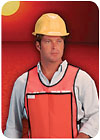
Today more than ever, workers have a wide range of personal cooling technologies from which to choose. With the summer months just around the corner, let’s look at five cooling garment options that can help your work crew beat the heat. As you review the technologies, remember the requirements of your particular application.
Umbilical fluid-chilled systems
Fluid-chilled systems consist of a garment, a fluid reservoir, a circulating pump and connecting hoses. The fluid reservoir holds ice to cool circulating fluid. The fluid in the reservoir is chilled by ice to 33º-34ºF, then circulated by the pump through tubing passages in the vest-like garment. As the fluid passes over the skin, the body transfers heat toward the cooler fluid, which then carries the heat back to the reservoir. As the fluid re-enters the reservoir, the process begins again.The circulation pump is operated by either batteries or an AC adapter. The temperature of the fluid at the body can be controlled somewhat by changing the speed of the pump motor. This regulates the rate of flow, which, in turn, determines the amount of heat drawn from the body.
Fluid-chilled systems are efficient, but mobility is limited because the reservoir and pump are separate from the garment.
PROS & CONS: Long-duration cooling, but formation of condensation can cause efficiency loss and dampness. Requires electricity or batteries. Limited mobility due to umbilical.
Pre-chilled or forced-air systems
Pre-chilled or forced-air systems consist of a torso garment, a compressor and an umbilical. The compressor forces pre-chilled air through the umbilical and into a bladder in the garment. The air is then forced against the body through a series of orifices in the inner surfaces of the garment. As the cooler air passes near the surface of the skin, it convectively draws heat away from the body and into the atmosphere.These systems are lightweight and provide efficient cooling, but mobility is restricted by the length of the umbilical. They also employ many moving parts in the compressor and require regular maintenance.
PROS & CONS: Lightweight and provides a comfortable cooling temperature range, but mobility is encumbered by umbilical. Expensive and requires electricity and regular maintenance.
Ice or gel pack vests
Ice or gel pack vests consist of a torso garment containing pockets, surrounding the chest cavity, that hold ice packs. The ice packs solidify at 32ºF. Body heat, carried to the surface of the skin by one’s circulatory system, is absorbed by the ice packs.The garment fully loaded with packs weighs typically 9-11 pounds, heavier than an umbilical-type garment, but is unattached to any external devices, making it portable. Cooling duration is approximately 1 to 1-3/4 hours between recharges based on average workload and individual metabolic rate. The packs recharge in about five hours in a freezer and can be recharged endless times.
The ice forms condensation because its temperature is below the typical dew point. The condensation generates heat, which is then absorbed by the pack, reducing the duration before another recharge is needed.
Ice technology provides a reduction of body core temperature when used for short periods. However, with prolonged use the body’s core temperature will actually begin to rise due to vasoconstriction. The body then attempts to retain heat when it should actually be giving up heat.
PROS & CONS: Inexpensive, portable (no umbilical device) and rechargeable. However, ice or gel pack vests can inadvertently fool the body into thinking it’s cold, which could be potentially dangerous. Can be very cold against skin. Bulky. Limited-duration cooling.
Phase change technology (PCMs)
PCM (phase change material) vests fit the torso and have pockets that hold PCM packs, similar to ice and gel pack vests. Body heat is absorbed by the packs, which operate at 59º-65°F. Wicking fabric carries perspiration away from the body toward the outside of the garment.Weighing 3-4 pounds, the garment is completely portable, with no umbilical. Cooling duration is typically 2.5 hours between recharges. The PCM packs recharge in 20 minutes in ice water or a freezer and can be recharged indefinitely.
PCM temperatures are well above the typical dew point so packs rarely form condensation and, therefore, remain dry. The temperature of PCM packs is within the comfort range of the body, so the garment can be worn for extended periods of time.
PCM cannot absorb as much heat as ice packs, but this limitation is offset by a lower loss of cooling potential to the ambient air temperature (because the differential between the ambient and the 59ºF packs is less than the differential between the ambient and 32ºF ice).
PROS & CONS: Comfortable temperature and dry against the skin; no undergarment required. Inexpensive, portable and easy to recharge. Bulkier than umbilical systems. Limited-duration cooling.
Evaporative cooling
Evaporative technology consists of a garment and a water absorption material. The garment is lightweight and the technology is inexpensive.To use the garment, soak it in water and put it on. The crystals in the cloth absorb water and hold it against the body. The process simulates the body’s evaporative cooling system of perspiration. There is some efficiency loss over natural perspiration evaporation because the water is not in actual conductive contact with the skin, but is actually cooling air between the absorption crystals and the skin.
While the concept is simple, evaporative technology works well only in warm, dry air, and won’t work in high humidity. The garment is always damp, which can cause skin irritation, bacterial growth, mold and odor.
PROS & CONS:Most inexpensive, lightweight, portable and medium-duration cooling. Won’t work in high humidity. Tends to be damp against the body.